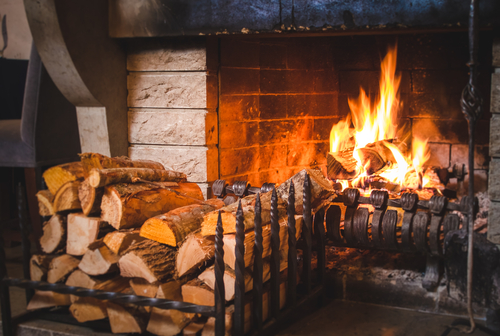There is little in nature that is more versatile than wood itself, and for so many reasons. Through the ages, wood has been used for providing fuel for fire for warmth and cooking facilities, for making weapons, furniture, shelter, the first really practical wheels, sea-going vessels, paper and cardboard, artistic creations and so much more. And let us not forget about the wood-fired ovens which make one of our favourite fast foods – pizza! The uses and applications of living and growing wood, as well as non-living cut wood, are incredibly vast and varied, which is why wood is so valuable in our lives.

Why are trees and shrubs so important?
Living wood – trees and shrubs – are invaluable in the environment by providing oxygen which improves air quality, by conserving water and preventing soil erosion as well as providing leaf mulch, supporting wildlife of many kinds and directly contributing to climate amelioration. Trees lower the air temperature and maintain low levels of carbon dioxide, thereby reducing the heat intensity of the well-known ‘greenhouse effect’ which is a global man-made problem. Trees directly contribute to rainfall levels. A 2012 study of trees in the Amazon found that plants help “seed” the atmosphere for rain by releasing tiny salt particles. Tree leaves act by catching falling rain which, in turn, evaporates and causes rainfall elsewhere. This is known as evapo-transpiration. When rain falls, the atmosphere is warmed and air rises, thus triggering circulation.
The lesson is all too clear : if forests and more and more individual trees are cut down, carbon dioxide levels in the air will increase, raising the earth’s temperature. Loss of trees and plants will result in loss of food and shelter for animals. If there are too few trees, the soil will not hold water, natural water table levels will drop and floods will result – all catastrophic events, whichever way you look at it. It is my firm personal opinion that the recent drought situation in the Western Cape where I have lived for many years is partly due to the continuous land-clearing and building work which is depleting the oxygen levels in the atmosphere. So many beautiful trees have gone, and the deterioration of our local climate continues.
Source your firewood from responsible sellers
Wood is still one of the cheapest and most popular fuels used globally for both heating and cooking, and it makes sense to choose those woods which are more easily renewable and most commonly found in each region. When you choose to buy woods for heating or the ever-popular braai during our glorious South African spring and summer months, buy from a supplier who sources his woods responsibly whilst still providing you with value and the right kind of wood for the purpose intended. A reputable and knowledgeable wood supplier comments that : “As a consumer, you have the right to ask where (the) wood you buy comes from and to see the seller permit”.
Namibia is particularly strict on the harvesting of wood (such as the Kameeldoring (Camel Thorn) tree) in this rather barren area, and cutting down trees can only be done with the appropriate permits having been obtained. There is a good reason for this, and we should all respect such laws in the ongoing effort to preserve our trees and help prevent climatic disaster. Harvesting wood from dead trees which have died naturally from drought or lightning strikes is acceptable – but this should be verified wherever possible.
Ten basic rules to remember when choosing your firewood
When it comes to indoor wood-burning stoves and fireplaces which are used during the winter months, as well as outdoor fires for warmth or cooking, there are a few common sense rules one should stick to, such as :
Avoid burning green or unseasoned wood. Seasoned wood has been repeatedly exposed to rain, wind and sun which, over a period of 18 – 24 months, dries the wood naturally and results in reduced smoke and more uniform burning.
Optimum moisture content for best burning and heat production is between 13% – 17%. Anything lower than 12% means that the wood will burn too quickly, whilst measurements over 18% mean that there is too much moisture and the wood will be difficult to ignite and will give off a black residue. All wood gives off creosote, which is a condensation of small, unburned particles in the smoke which coats the chimney surface as it rises. This creosote sticks to the sides of the chimney and could ignite, causing a chimney fire.
Don’t burn old Christmas trees. Whilst it may be tempting to throw your tatty dead Christmas tree onto a fire, be aware that the needles of these trees ignite extremely quickly and these trees are full of sap which is extremely flammable and also produces a large quantity of creosote, which can send out flaming sparks. Pine wood produces a resin that deposits an invisible film inside the flue pipe of an indoor fireplace which becomes a serious fire hazard over time. Be responsible, and choose an artificial tree which will last for years and will not involve cutting down otherwise perfectly healthy adult trees just for short-term decorative purposes.
Driftwood. This wood contains salt (chemically known as sodium chloride), so salt-water driftwood produces dioxin, which is toxic to humans and animals, when burned. Whilst it might be beautiful to watch the dazzling colours produced during burning, always be aware that these beautiful colours are the result of toxic chemicals being released into the air.
Do not burn poisonous wood. Many people are unaware, for instance, that all parts of the decorative garden Oleander tree are poisonous to both humans and animals. Don’t even think of using a branch over a fire to toast marshmallows, don’t braai your meat over it, and don’t risk breathing in its smoke. Ingestion of this plant in any form can adversely affect your digestive system, your heart and the central nervous system.
Avoid burning plywood, particle board or chipboard. These boards are manufactured and glued together using high-strength adhesives, therefore the smoke from these fires will be filled with toxins.
Avoid using painted or stained wood, as these contain toxic chemicals which are released when burned.
Do not burn pressure-treated lumber. This wood is coated or soaked in wood preservatives which are aimed at extending the life of the wood by preventing rotting, weathering and becoming insect-fodder. Burning this wood will release toxic chemicals which should not be inhaled.
Stay clear of wood pallets as fire material, as many of these contain toxic chemicals. Take them to the dump or be crafty and re-use them in DIY projects.
There are many firewood suppliers out there, and not all of them are sourcing their wood responsibly, so please do your bit in supporting and preserving our beautiful land by ensuring that you only use wood from bona-fide suppliers. It may be more time-consuming and cost a little more, but you will be acting in the interests of far more than your stomach and the comfort of a warm, cozy fire in the winter.
